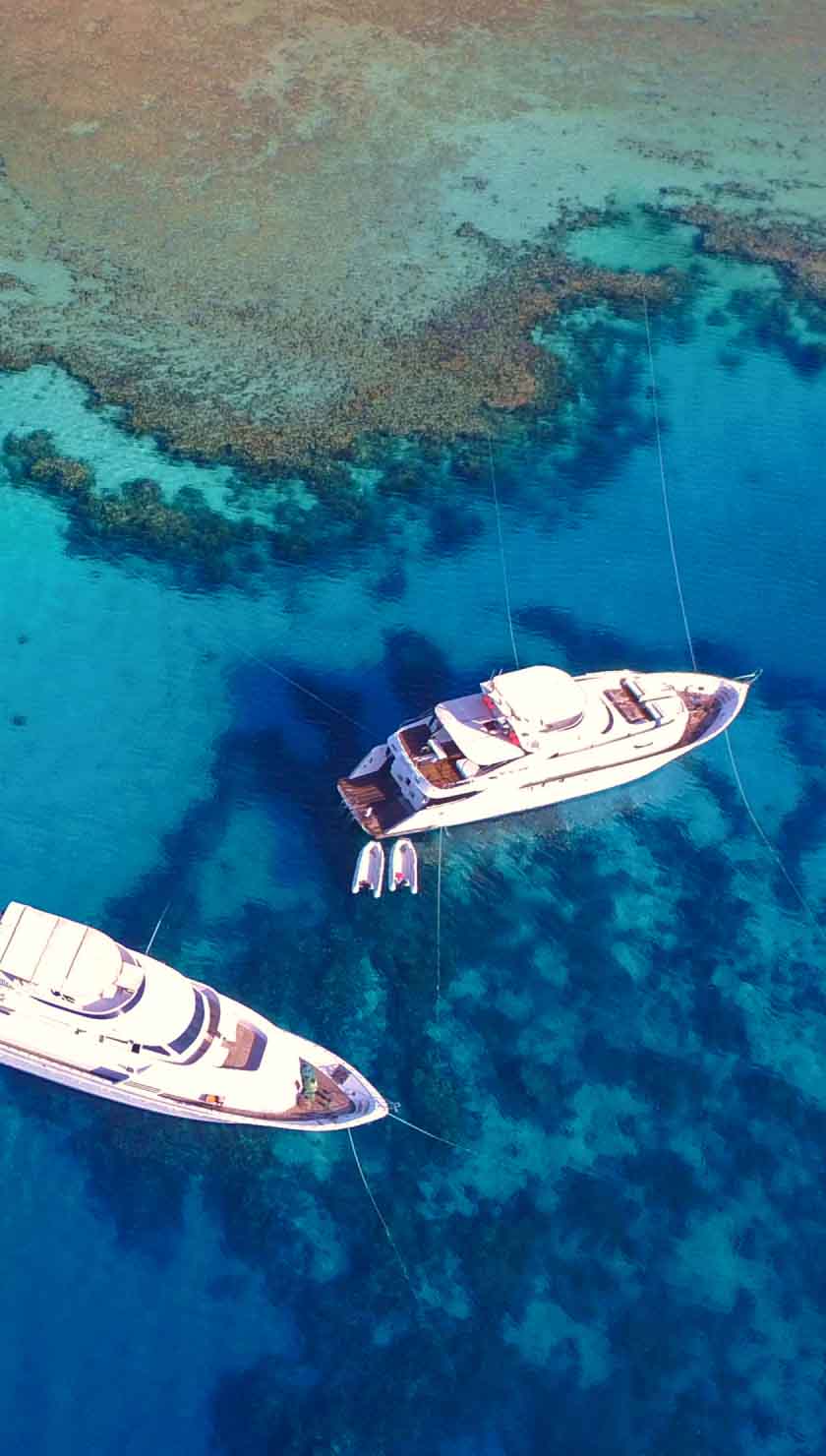Tauchsafaris in Malé-Atoll
Liveaboard-Tauchplätze des Malé Atolls
Das Malé-Atoll wird technisch als Kaafu-Atoll bezeichnet, ist aber unter jedem Namen das klassische Malediven-Atoll, das am besten bekannt und erforscht ist. Malé ist in das Nord- und das Süd-Atoll unterteilt, die beide als erste im Land für den Tourismus geöffnet wurden, wobei das Süd-Atoll vor dem Nord-Atoll geöffnet wurde und noch mehr Resorts und Tauchplätze bietet. Nord Malé hat beliebte Manta-Reinigungsstationen, eine großartige Topographie und einige Korallengärten, die mit einigen der schönsten Riffe der Welt vergleichbar sind. Süd Malé ist berühmt für seine Kandus, Kanäle, die reißende Ströme von nährstoffreichem Wasser aus dem offenen Ozean in das Atoll bringen, zusammen mit großen pelagischen Fischen, die der Nahrung folgen. Haie gibt es zwar sowohl in Nord- als auch in Süd Malé, aber das südliche Atoll ist am besten für sie bekannt. Der Norden hingegen ist besser erhalten und etwas ruhiger.
Im Nord Malé-Atoll dürfte der Manta Point der berühmteste Tauchplatz sein. Sein Name spricht für sich selbst - wenn Sie ihn besuchen, machen Sie sich darauf gefasst, mehr Mantas zu sehen, als Sie zählen können, ebenso wie Haie und andere Riffbewohner. Nirgendwo sonst auf den Malediven können Sie so kurz nach Ihrer Ankunft an einem internationalen Flughafen ins Wasser springen, um Mantas zu sehen. Der andere Spitzenplatz in Nord Male ist das Girifushi Thila, das als einer der besten Tauchplätze der Malediven gilt. Die Strömung ist hier ganztägig, so dass Sie einen Strömungstauchgang inmitten von farbenfrohen Weichkorallen und Wasser voller Fische, darunter Rochen, Haie und Thunfische, erwarten können.
Die Vielfalt der Tauchplätze im Nord Malé Atolls bietet für jeden Geschmack etwas. Einer der beliebtesten und zuerst entdeckten Tauchplätze ist das Banana Reef, das noch immer ein gesundes Dickicht aus verzweigten Korallen aufweist. Entlang der Kurve dieses bananenförmigen Riffs sind Riesenzackenbarsche und Muränen zu finden. Ein riesiger Schwarm Wimpelfische hängt in der Strömung am Rande und ein paar unglaubliche Höhlen laden zur Erkundung ein. In einem anderen Bereich hat sich das beeindruckende 100 Meter lange Wrack der Maldives Victory über dreißig Jahre lang von Meeresbewohnern besiedeln lassen. Zum Glück gibt es eine Linie für den Auf- und Abstieg, denn die Strömung kann sehr stark sein. Sobald Sie einen geschützten Bereich gefunden haben, können Sie sich an den großen und kleinen Fischen und Wirbellosen erfreuen, die dieses Wrack zu ihrem Zuhause gemacht haben.
Mehr Haie gibt es bei Miyaru Faru, wo Taucher das Blauwasserspektakel von einem sicheren Überhang an der Wand aus beobachten können. Die ankommende Strömung bei Miyaru Faru bringt kristallklares Wasser und pelagische Tiere, darunter Mantas, Adlerrochen, Thunfische und mehr. Und für unerfahrene Taucher hat Nord Male tatsächlich großartige Plätze zu bieten. Zwei atemberaubende Tauchplätze, die relativ strömungsfrei sind, sind Hans Haas Place mit vielen Überhängen und kleinen Höhlen und Back Faru, der ein gutes Riff- und pelagisches Leben unter unglaublich stressarmen Bedingungen bietet.
Die sechs großen Kanäle des Süd-Male-Atolls, auch Kandus genannt, sind nicht für ihre Korallen bekannt, aber sie bieten ein erstaunliches pelagisches Leben, große Fischschwärme und jede Menge Haie. Cocoa Thila ist einer der berühmtesten Tauchplätze in Süd Malé. Wenn Sie die perfekte Strömung haben, können Sie Rochen und alles andere sehen. Zum Glück gibt es einige Einbuchtungen und Höhlen in der Topographie, in denen sich Taucher ausruhen können, während sie das Treiben beobachten. Das Cocoa Thila ist eine große Felsnadel, die in tiefem, tiefem Wasser liegt, und es befindet sich am Rande des Süd Malé Atolls. Das bedeutet, dass Sie möglicherweise einen Strömungstauchgang in der gleichen Währung absolvieren, die auch die großen Meeresbewohner anlockt.
Guraidhoo Kandu South umfasst eigentlich viele Tauchplätze unter einem Namen. Es handelt sich um ein großes Gebiet, das nicht in einem einzigen Tauchgang abgedeckt werden kann, und die Vielfalt seiner Topographie trägt zum Gefühl vieler verschiedener Tauchplätze bei. Hier können Taucher auf einer vertikalen oder horizontalen Ebene abtauchen, von Wänden über Ebenen und Kanäle bis hin zu Höhlen. In Guraidhoo Kandu South gleiten Haie durch die Wasserstraßen, während tausende verschiedener Riffbewohner ihre Löcher und Verstecke genießen. Aber wenn es um Haie geht, steht Embudhoo Kandu in Süd-Male ganz oben auf der Liste. Embudhoo Kandu beherbergt eine gesunde Population von Weißspitzen- und Grauen Riffhaien. Das Meeresschutzgebiet wurde eingerichtet, um sicherzustellen, dass dies auch in Zukunft so bleibt.
Neben dem Cocoa Thila ist das Kandooma Thila als der beste Tauchplatz des Süd Male Atolls bekannt. In einem schmalen Kanal an der Seite dieses Thilas sorgt eine starke Strömung für eine verrückte Menge an Aktivität, darunter Schwärme von Barrakudas und anderen großen Raubfischen. Das Kandooma Thila ist ein weiterer Tauchgang, bei dem man mit der Strömung zurechtkommen muss. Die Felsnadel bietet während eines Teils des Tauchgangs Schutz, aber schließlich werden Sie mit einer Markierungsboje für das Ende ins Blaue abgetrieben. Weitere Tauchplätze in Süd-Male sind die Vadhoo-Höhlen und das Kuda Giri Wrack. In den Vadhoo Caves bietet eine Höhle nach der anderen die Möglichkeit, mit den Riffbewohnern in einem Garten aus bunten Weichkorallen zu entspannen, während Sie im angrenzenden Freiwasser Haie beobachten können. Am Kuda Giri Wrack haben unerfahrene Taucher die Möglichkeit, ins Wasser zu springen und das künstliche Riff und seine Bewohner mit wenig oder gar keiner Strömung zu erkunden.
Details zur Reiseroute
Die Länge der Tauchsafaris im Malé Atoll liegt in der Regel zwischen 7 und 10 Nächten, bei einem Budget von etwas über 200 bis 350 Euro pro Nacht. Tauchsafaris im Male-Atoll führen fast überall auf den Malediven hin; es gibt für praktisch jeden Taucher eine Tour, die seinen besonderen Vorlieben und seinem Zeitrahmen entspricht. Die kürzesten Trips machen eine Schleife in den zentralen Atollen. Manchmal werden die Touren in eine nördlich-zentrale und eine südlich-zentrale Option aufgeteilt, um etwas mehr von Ari oder Baa (im Norden) oder Vaavu/Meemu (im Süden) zu sehen. Besuchen Sie Scubaspa Ying und Yang und viele andere Boote für diese klassischen Malediven-Routen. Größere und umfangreichere Schleifen oder Traversen führen in alle Richtungen (Beispiele für Tauchsafaris sind Carpe Vita und Carpe Diem). Bei den Tauchsafaris im Malé Atoll handelt es sich meist um MV-Yachten und Luxusyachten.
Das von den Tauchsafaris im Baa Atoll verlangte Erfahrungsniveau reicht von null bis 100 geloggten Tauchgängen, wobei einige Boote einen Open Water-Schein und andere einen Advanced Open Water-Schein haben. Für Anfänger gibt es einige Angebote rund um Malé, aber im Allgemeinen sollten Sie sich darauf einstellen, dass viele der Tauchgänge Strömungstauchgänge sind, vor allem in den Kandus im südlichen Teil.
Start der Tauchsafari mit Liveaboards
Male ist der Hauptabfahrtsort für Tauchsafaris auf den Malediven und die Hauptstadt des Landes. Sie befindet sich am südlichen Rand des Nord Male Atolls. Der wichtigste Abfahrtshafen für Tauchsafaris in Male ist Hulhule, direkt neben dem Flughafen von Malé, so dass es praktisch möglich ist, aus dem Flugzeug zu springen und auf ein Boot zu steigen. Taucher, die das Male-Atoll ansteuern, können Direktflüge aus Dubai, Singapur und Colombo nehmen. Längere internationale Flüge aus Europa, Amerika, China, Indien und Australien sind ebenfalls leicht verfügbar, oft mit Anschluss an die oben genannten Flughäfen.
Beste Reisezeit
Tauchen ist im Malé Atoll das ganze Jahr über möglich, aber der Nordostmonsun von Dezember bis Mai bietet die ruhigsten Oberflächenbedingungen und den wenigsten Regen. Aber auch in der feuchteren Jahreszeit, von Juni bis November, regnet es im Male Atoll weniger als in den weiter südlich gelegenen Gebieten des Landes. Mantas sind das ganze Jahr über anzutreffen. Die Wassertemperatur liegt in der Regel zwischen 26 und 29 Grad und die Sichtweite zwischen 15 und 30 Metern.











